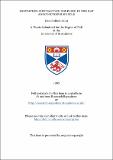Files in this item
Excitation-contraction coupling in the rat anococcygeus muscle
Item metadata
| dc.contributor.advisor | Nicol, C. J. M. | |
| dc.contributor.author | Saint, David Albert | |
| dc.coverage.spatial | 98 p. | en_US |
| dc.date.accessioned | 2018-07-02T11:16:19Z | |
| dc.date.available | 2018-07-02T11:16:19Z | |
| dc.date.issued | 1982 | |
| dc.identifier.uri | https://hdl.handle.net/10023/14799 | |
| dc.description.abstract | Smooth muscles as a group exhibit great diversity of pharmacological and physiological properties. This makes it impossible to produce any but extremely generalised schemes for smooth muscle contractile mechanisms. However, knowledge of the detailed physiology and pharmacology of specific types of smooth muscle has been growing at an increasing rate, especially regarding vascular and visceral muscles. The rat anococcygeus muscle has, however, been investigated little. This work describes the excitation- contraction coupling mechanism in this preparation. The rat anococcygeus muscle was found to contract to all three of the agonists used (noradrenaline, acetylcholine and potassium chloride). In the first section of this work the properties of these contractions were investigated. It was found that the contractions induced by each agonist exhibited different pharmacological properties, (with regard to low calcium, sodium nitroprusside, verapamil, Stellazine and theophylline). This can be taken as an indication that the different agonists use different activation pathways. Electrophysiological studies showed that the membrane potential per se is not important in the regulation of contraction. (ie. the depolarisation produced by an agonist is not simply related to the tension produced ). KC1 produces the greatest change in membrane potential (from -55mV to -20mV for a maximal dose), but produces the least rise in tension of the three agonists. Evidence from other preparations and the results of the experiments with Stellazine suggest that the rise in tension produced by the agonists is not simply related to the rise in intracellular calcium concentration, but that some amplification of the response occurs. The way in which the agonists produce this amplification of the response is suggested as being related to changes in the levels of the cyclic nucleotides, cAMP and cGMP within the cells. It was found that the agonists did not substantially affect cAMP levels, but that all three reduced cGMP levels by varying amounts. The ratio of the levels of cAMP/cGMP produced by activation with each agonist correllates very well with the tension produced. This suggests that the ratio cAMP/cGMP is important in the regulation of contractility in this muscle. However, doubt is cast upon this theory by the results of experiments using sodium nitroprusside (NP). It was found that NP (2 X 10-7M) caused a pronounced change in the ratio cAMP/cGMP (by increasing cGMP levels ), but only a small change in tension (so that the tension in these experiments does not correllate well with the ratio cAMP/cGMP). In order to retain the hypothesis that cyclic nucleotides are important in the regulation of contractility in this preparation, it is proposed that some form of compartmentalisation of the cyclic nucleotide changes occurs within the cells. | en_US |
| dc.language.iso | en | en_US |
| dc.publisher | University of St Andrews | |
| dc.subject.lcc | QP321.S2 | |
| dc.subject.lcsh | Muscle contraction | en |
| dc.title | Excitation-contraction coupling in the rat anococcygeus muscle | en_US |
| dc.type | Thesis | en_US |
| dc.contributor.sponsor | Medical Research Council (MRC) | en_US |
| dc.type.qualificationlevel | Doctoral | en_US |
| dc.type.qualificationname | PhD Doctor of Philosophy | en_US |
| dc.publisher.institution | The University of St Andrews | en_US |
This item appears in the following Collection(s)
Items in the St Andrews Research Repository are protected by copyright, with all rights reserved, unless otherwise indicated.

